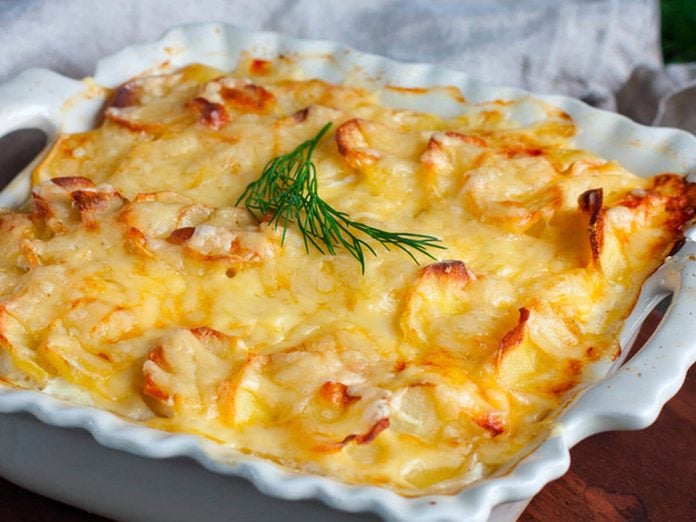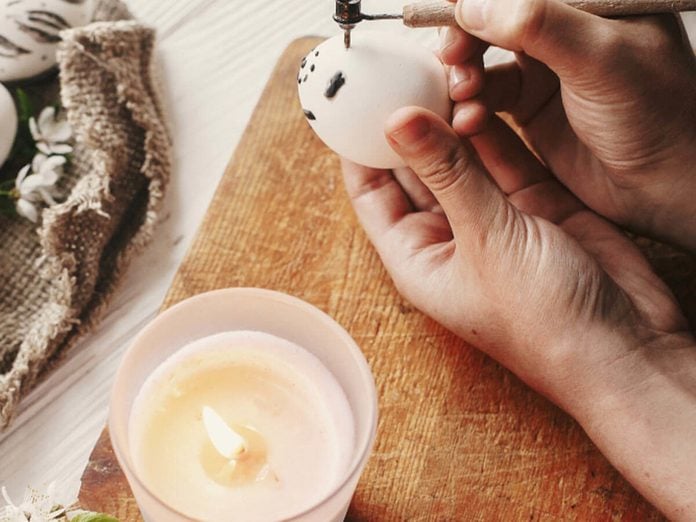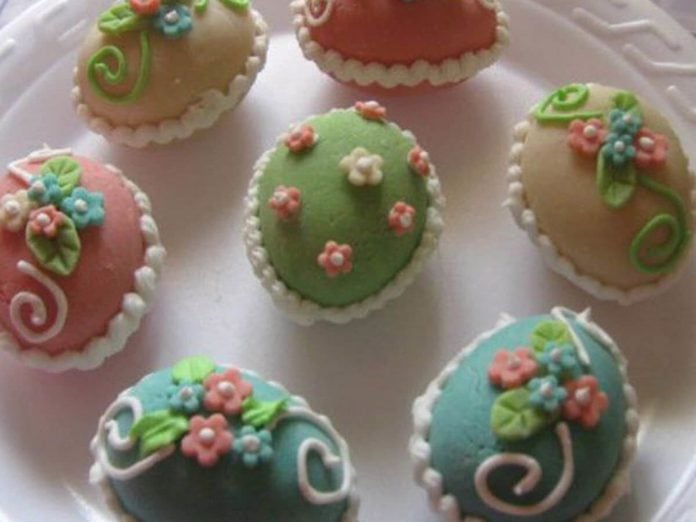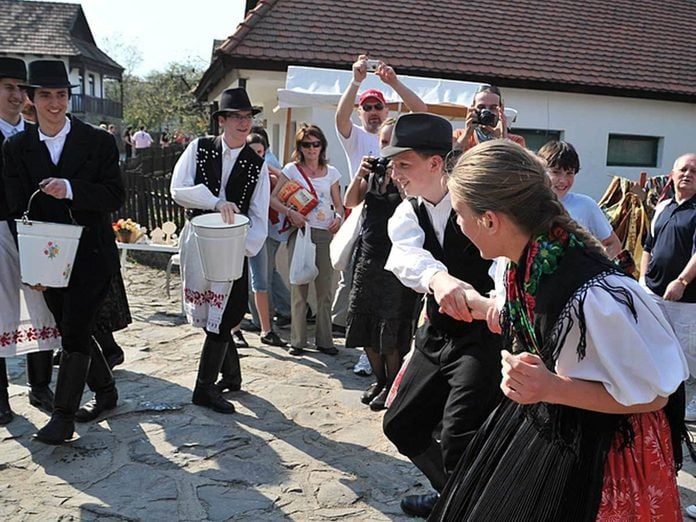
Eggs Rolls are Symbolic of the Rolling Away of the Stone from Christ’s Tomb
Egg rolls, like the one that takes place every year at the White House, go back hundreds of years. The U.S. started hosting an egg roll back in 1814 with James and Dolley Madison. Kids in the U.S. use a wooden spoon to keep an egg rolling while in Scotland kids try to have their egg roll the farthest.

Egg Dance
In Germany there is an old game where people dance around eggs and damage as few as possible.
Plant the idea of starting a garden with an egg carton.

Egg Tapping
Egg tapping takes place throughout the world in different forms. In egg tapping people grab an egg and tap the pointed end against someone else’s egg. Whoever’s egg doesn’t break is thought to have good luck for the next year.

Egg Tile Rolling
Sweden puts a twist on egg rolling by rolling eggs down a roof tile held at an angle to the ground to see whose egg goes the farthest. If someone’s egg gets hit, they get to keep their egg and the egg that hit theirs.
Just don’t grab a tile from your roof to play the game. Make sure your roof is holding up by learning the warning signs.

Giant Chocolate Egg
Argentina puts on a big Easter egg celebration each year when it unveils the Huevo de chocolate in Bariloche. The hollow chocolate egg uses more than 17,500 pounds of chocolate and stands nearly 30 feet tall. Around 50,000 people turn out each year and get to eat some of the egg after it gets cracked open with a pick ax.
Afraid your ax wouldn’t break open a chocolate egg?

Mexican Easter Egg Showers
In Mexico and parts of the southern U.S. a custom is to hide hollowed out eggs filled with confetti. Once the eggs are found they can be broken over peoples’ heads and the confetti rains down. The hollowed out eggs are called cascarones.
Make sure leaves are flying around like confetti in your backyard by learning these mulching tips.

Blessing Basket
In Poland families prepare blessing baskets filled with colored eggs, sausages, bread and other food the day before Easter to bring to a priest to get blessed. Lent isn’t over until a priest blesses the basket.

Egg Jarping
Egg jarping is played in England and essentially the same as egg tapping, it just has a cooler name. One player holds their hard-boiled egg pointed end up and a second player brings their egg down so pointed eggs collide. The person with an undamaged egg wins.

Chocolate Egg Begging
In Finland, children dress up like witches and go begging for chocolate Easter eggs from door-to-door. They also carry willow twigs, wear scarves over their head and make-up their faces.
Make sure you’re pruning a tree the right way before grabbing willow twigs for Easter.

Giant Omelet
Easter brunch takes on a different look in Haux, France where each year a giant omelet gets made on Easter Monday. The omelet uses 4,500 eggs for around 1,000 people. According to legend, the tradition stems from Napoleon when he and his army stopped in a small town to get omelets. He ordered the town to gather their eggs and make a giant omelet for him and his army the next day.
You probably don’t have to feed 1,000 people but don’t keep visitors waiting on an omelet with a dirty skillet. Check out the best way to clean a cast iron skillet.
Photo: Courtesy of Agnès Landou/My French Life

Engraved Ostrich Eggs
Decorating eggs as part of a spring ritual actually dates back 60,000 years ago. Archaeologists discovered ostrich eggshells in the Kalahari Desert, which were used as water flasks, that were sometimes decorated with patterns engraved.
See what you need to do to save water during an emergency situation.

Use Up Eggs Before Lent
Centuries ago eggs were to be consumed before the start of Lent because they were forbidden to eat during Lent. People couldn’t stop chickens from laying eggs during Lent, however, but several traditions emerged after Lent involving egg dishes.
Keep food from spoiling around the house by learning what you should keep out of the fridge.

Meatloaf With Egg
Though we’ve often seen Meatloaf with egg on his face but the dish, meatloaf, stuffed with hardboiled eggs is a Greek tradition called, Rolo Kima.

Hornazo
Hornazo is a Spanish meat pie filled with pork loin, chorizo sausage and hard-boiled eggs typically eaten around Easter. The inclusion of the hard-boiled egg is a holdover from the days of when people hard-boiled eggs that chickens laid during Lent to preserve them since eggs were forbidden during Lent.
Photo: Courtesy of Juan Fernández/Wikipedia

Hungary Potato Casseroles
Potato casseroles with hard-boiled eggs are pretty standard for Hungary. The dish, rakott krumpli includes Hungarian sausage, onion, sour cream, breadcrumbs and paprika.

Blessed Eggs
Orthodox churches will bless Easter eggs and distributed to the congregation. The egg is viewed as a symbol of resurrection with a new life sealed in it.
See what you can put into an egg carton other than eggs this spring.

Eggs to the Cemetery
After people have their eggs blessed by a priest people will bring them to the cemetery to place on the graves of loved ones who have died.

Onion Skins and Vinegar
Easter egg dying kits are the route most people take to creating their colorful decorations but the traditional path has been using onion peels. Just boil some onion skin peels in water and vinegar and later add the eggs.

Filling Eggs With Money Instead of Candy
What’s better than finding more candy in an Easter egg? Finding money to buy more candy in an Easter egg. For some people placing money in an Easter egg is a custom, maybe a bunch of dentists.

Easter Egg Centerpieces
At Easter people will include Easter eggs with their centerpiece to keep the egg motif going as the nosh on some quiche. It makes for an easy centerpiece idea and it’s way to hide the ugly Easter eggs.

Birds and the Bees
Beeswax is a common tool used to decorate Ukrainian Easter eggs. The designs are written with beeswax, not painted on.

Breaking Hard-Boiled Eggs
In the Mediterranean the hard-boiled eggs used to decorate the house become toys and snacks for kids on Easter day. Kids will duel with the eggs and then eat them afterward.
Check out these tips to make sure your carpet stays clean after a duel between egg-wielding kids.

Eggs in Trees and Bushes
Germans have long decorated trees and bushes with Easter eggs and call the tradition the Ostereierbaum. Volker Kraft from Saalfeld, Thuringia in central Germany has decorated an apple tree on his land since 1965 and has hung more than 10,000 eggs at one time. The tree drew the curious through the years, to the tune of 8,000 visitors back in 2011 but 2015 served as the final year for the spectacle.
If it’s time to take down a tree, see how to cut a tree down safely.

Eggs are Dyed Red to Represent Jesus
More specifically, red is used to symbolize the blood of Christ and the egg tends to represent the Jesus’ tomb.

Orthodox Christians Abstain From Eggs During Lent
While abstaining from meet is typical during Lent, eggs and dairy were usually included centuries ago. Some Eastern Christian Churches continue to abstain from consuming eggs during Lent.
Check out a crazy idea on how to reuse egg cartons in the bathroom.

Eggs Symbolize Dead, Too
The egg can represent the dead, too. In Ukraine people used to keep krashanky, the ornate eggs, in a bowl on a table to represent the number of deceased family members.
Quiet the critics by having your table top spotless this Easter with these tips.

Willow Whips
Slavic nations have a tradition of using willow whips to playfully spank women on Easter. The tradition is said to keep women’s health, beauty and fertility for the next year.

Pace Egg Plays
Pace Egg Plays held widespread popularity throughout England at one time but now the tradition remains largely only in Lancashire and West Yorkshire. Pace Egg Plays are usually depictions of combat between a hero and villain where the hero is killed, then brought back to life by a quack doctor.
Photo: Courtesy of Phil Champion/Wikipedia

Marzipan Eggs
In Goa, India Marzipan is used to make Easter eggs. Marzipan is a confection made of sugar or honey and almond meal.
Keep some homemade honey around with some backyard beekeeping.

Faberge Eggs Originally Easter Gifts to Wives
Faberge eggs were created from 1885 and 1917 for the Russian Tsars under the guidance of Peter Carl Faberge. The eggs were given as Easter gifts to the wives of the Tsars. The Tsars allowed Faberge complete freedom to design the eggs, the only requirement was that it needed to have a surprise.

Dyed Red Eggs to Ward Off Evil
Greeks used keep the first dyed red egg on display to help ward off evil as one of their traditions.
Ward off some scary problems by taking a look at home inspector horror photos so you know what to avoid.

Lambs Marked with Red on Heads and Backs
Greeks also used to mark the heads and backs of lambs to protect them from evil.
Treat the animal in the house — your dog or cat — like royalty with some of these 17 awesome tips.

Egg-Laying Hare
The Easter bunny comes from the Germans and represents a symbol of fertility, just like the egg. Somewhere down the road the idea of an egg-laying hare sprouted up in the U.S. in the 1700s, though it likely came from German immigrants in the Pennsylvania Dutch region.
Rabbits, because of their fertility, have become a nuisance across the country.

Eggs Were Possibly Buried
It’s long been said that Christians began celebrating holy days at the same time as spring festivals as an attempt to win converts. Eggs were part of the spring festivals and were possibly buried in fields to promote fertile soil and a healthy crop.
Dig these tips on digging a hole so you don’t hurt yourself.

Eggs Given to Poor Who Couldn’t Afford Meat
Since eggs were originally forbidden to eat during Lent they’d pile up during Lent. To avoid having them spoil people hard-boiled them and then shared with those who had trouble affording meat.
Make sure all that stuff you buy in bulk doesn’t spoil with these tips.

Eggs Given to Lords in England
Back in the 1200s in England, people used to give eggs as a gift to their respective lords every Easter. Eventually the giving of eggs turned into the giving of cash.
See what you should give away to get rid of some of the clutter at home.

Girls Doused with Water, Give Eggs
In the Czech Republic, Hungary and Slovakia there is a tradition to douse women with water, though frequently the women are sprayed with perfume in Hungary. The men in Hungary receive an egg in exchange. In the Czech Republic and Slovakia the women can return the favor by dousing the men with water the next day.
Get that kink out of the garden hose this spring so you don’t have to buy a new one.

Horseshoes
We all know horseshoes can be good luck, depending on which way they point on a wall. They also make their way to eggs at Easter in Hungary.

Easter Trees with Easter Eggs
It’s not quite on the same scale as the Easter tree in Germany but for many people an Easter tree is used as a centerpiece for the meal. Just don’t get caught plucking candy from the tree during brunch and ruin your appetite.

Wash Face With Water That Egg Sat In
Serbia serves up an amalgamation of traditions in eastern Europe with this one. The first red egg is believed to be the protector of the house and to be buried in the yard as a way to ensure protection of the crops. After all that, someone is to wash their face in the water where the egg, basil, cornel and geranium sat all night. It sounds a little like a chain letter but we’ll pass it along … just in case.
Get yourself a stunning bathroom vanity so the image you’re cutting by washing your face with old egg water is a little more palatable.

Children’s Cheeks Rubbed With Red Egg
Kind of like with Finland where the children have rosy cheeks, children in Serbia have their cheeks rubbed by a red egg so that they will be healthy and rosy all year.
See how someone felt rosy after learning how to deal with Japanese beetles in their rose garden.

Bread Baked With an Egg on Top
Bread baked with an egg, called kovrznjak, is a tradition in Serbia where friends exchange the dish.
You may not be the bread-baking type but you’ve probably got those bread tabs all over the place.

Eggs Given to Cattle
Eggs are given to cattle each Easter to make sure they stay healthy during the whole year, much like a cracked egg is left in the field to keep the soil fertile.

Easter Bells
When Napoleon’s not demanding omelets for his army, the French are using church bells to deliver Easter eggs. Well, sort of. The bells stop ringing in France on Maundy Thursday to mourn Christ’s death and they remain silent until Easter Sunday. The legend has it that the bells went to Rome to get blessed and picked up eggs on their way back to France. As they got back to France they scattered eggs in gardens across the country.
Keep your garden looking great to make those eggs easy to find with things like a no-stick shovel.

Delivering Eggs
Bosnia and Herzegovina celebrate Easter a little like Halloween because children go door-to-door to wish people a happy Easter. Those people give the children a colored Easter egg. Later the kids play an egg-tapping game.

Decorative Eggs
Use copper wire to make decorative eggs, often referred to as “Czech eggs.” Just wrap copper wire around a hard-boiled egg or a plastic egg. You can add beads or even decorate the eggshell, depending on your style.

Breaking Stringed Eggs
Latvians have a slightly different take on egg tapping by putting a string on the eggs.

Chocolate Eggs in Italy with Hidden Gifts
Italians offer a grand gesture with their Easter eggs. Hollowed-out chocolate eggs get filled with awesome gifts inside like jewelry.
Keep your jewelry hidden with the best hiding places in the house.

Eggshells on Water
The eggs used for the pasca, a special Easter cake, are later thrown in a river as a way to protect hens from hawks but primarily as a way to signal to spirits that Easter is over.

Beaded Eggs
Romanians take the egg decorating in a different direction by placing beads on their Easter eggs. The beads are placed in a traditional pattern and sometimes get blessed at church.